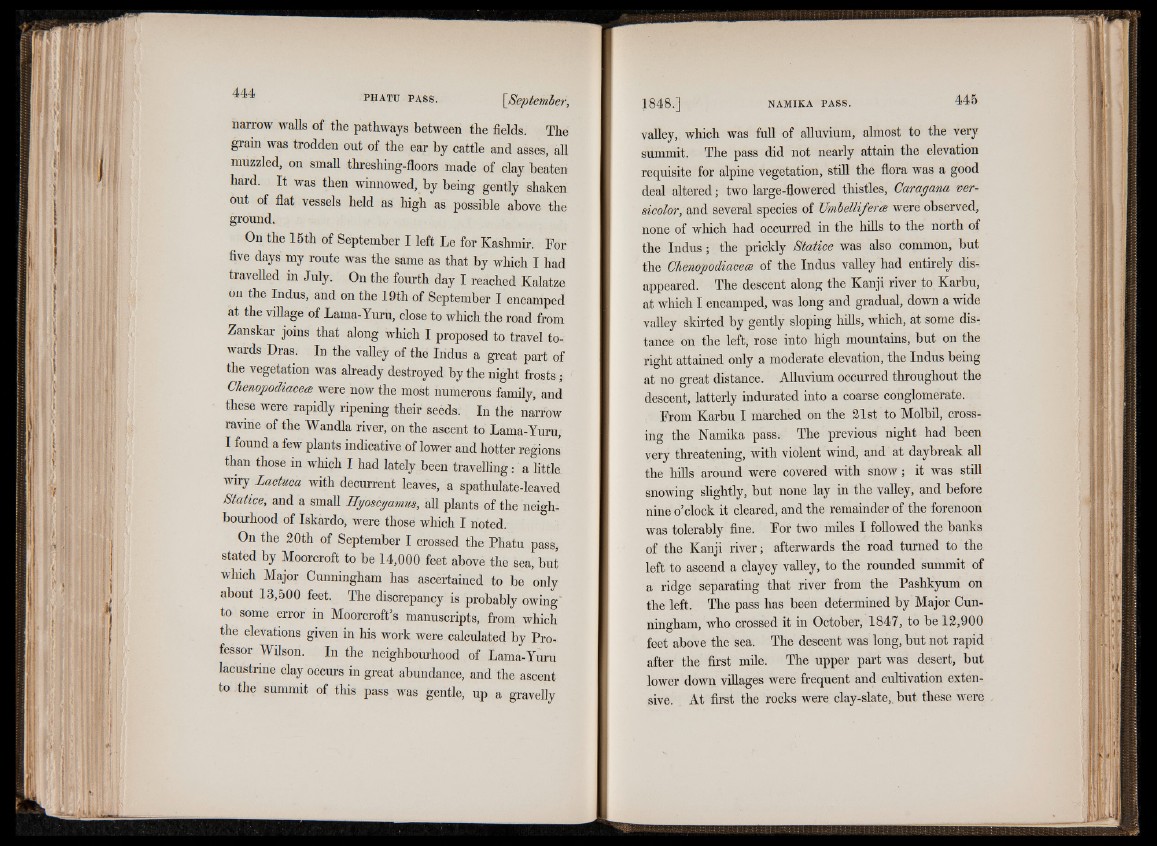
narrow walls of the pathways between the fields. The
grain was trodden out of the ear by cattle and asses, all
muzzled, on small threshing-floors made of clay beaten
hard. It was then winnowed, by being gently shaken
out of flat vessels held as high as possible above the
ground.
On the 15th of September I left Le for Kashmir. For
five days my route was the same as that by which I had
travelled in July. On the fourth day I reached Kalatze
ón the Indus, and on the 19th of September I encamped
at the village of Lama-Yuru, close to which the road from
Zanskar joins that along which I proposed to travel towards
Dras. In the valley of the Indus a great part of
the vegetation was already destroyed by the night frosts ;
Chenopodiacea were now the most numerous family, and
these were rapidly ripening their seéds. In the narrow
ravine of the Wandla river, on the ascent to Lama-Yuru,
I found a few plants indicative of lower and hotter regions
than those in which I had lately been travelling.- a little
wiry Lactuca with decurrent leaves, a spathulate-leaved
Statice, and a small Hyoscyamus, all plants of the neighbourhood
of Iskardo, were those which I noted.
On the 20th of September I crossed the Phatu pass,
stated by Moorcroft to be 14,000 feet above the sea, but
which Major Cunningham has ascertained to be only
about 13,500 feet. The discrepancy is probably owing'
to some error in Moorcroft’s manuscripts, from which
thè elevations given in his work were calculated by Professor
Wilson. In the neighbourhood of Lama-Yuru
lacustrine clay occurs in great abundance, and the ascent
to the summit of this pass was gentle, up a gravelly
valley, which was full of alluvium, almost to the very
sum m i t- The pass did not nearly attain the elevation
requisite for alpine vegetation, still the flora was a good
deal altered; two large-flowered thistles, Caragana versicolor,
and several species of ünbelliferß were observed,
none of which had occurred in the hills to the north of
the Indus; the prickly Statice was also common, but
the Chenopodiacece of the Indus valley had entirely disappeared.
The descent along the Kanji river to Karbu,
at which I encamped, was long and gradual, down a wide
valley skirted by gently sloping hills, which, at some distance
on the left, rose into high mountains, but on the
right attained only a moderate elevation, the Indus being
at no great distance. Alluvium occurred throughout the
descent, latterly indurated into a coarse conglomerate.
From Karbu I marched on the 21st to Molbil, crossing
the Namika pass. The previous night had been
very threatening, with violent wind, and at daybreak all
the hills around were covered with snow; it was still
snowing slightly, but none lay in the valley, and before
nine o’clock it cleared, and the remainder of the forenoon
was tolerably fine. For two miles I followed the banks
of the Kanji river; afterwards the road turned to the
left to ascend a clayey valley, to the rounded summit of
a ridge separating that river from the Pashkyum on
the left. The pass has been determined by Major Cunningham,
who crossed it in October, 1847, to be 12,900
feet above the sea. The descent was long, but not rapid
after the first mile. The upper part was desert, but
lower down villages were frequent and cultivation extensive.
At first the rocks were clay-slate,. but these were